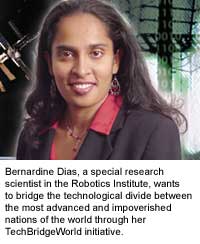Typically, bridges are used to connect people to places. But what about a bridge that connects people to technology?

Bernardine Dias wants to bridge the technological divide between the advanced nations of the world and the four billion most impoverished citizens who have been left behind.
Dias is founder and director of Carnegie Mellon University’s TechBridgeWorld initiative. She and her team want to change the way technology is provided to developing countries looking for solutions in agriculture, education, health care and the environment.
Solutions like creating an ad-hoc wireless network to provide early warnings for tsunamis, a project near to her heart. A native of Sri Lanka, she was visiting relatives there last December when the devastating tsunami struck.
While many organizations have studied the process of development, the TechBridgeWorld initiative focuses on how advanced technology can benefit communities in the development process and benefit from the wealth of knowledge in these communities to encourage further innovation.
The overall goal of the TechBridgeWorld initiative is to empower people in developing communities to become producers and consumers of advanced technology relevant to their needs. It’s the difference between just giving someone a fish and teaching them to fish.
TechBridgeWorld programs are very hands-on, stressing collaboration and sharing ideas. “This is not a one-way street,” Dias said. If the bridge is built properly, the benefits will go both ways, as reflected in the TechBridgeWorld initiative’s long-term goals: sharing of technological innovation, increasing cultural awareness and tolerance, increasing the number of self-sufficient communities throughout the world, and improving lives through technology. These things can only happen if the bridge is strong in both directions.
The Bridge’s foundation rests on special courses and programs offered through Carnegie Mellon’s School of Computer Science, which encourage students to realize the potential impact of their work in non-traditional settings. The initiative is building upon this foundation through small-scale project implementations in developing communities.
In a course called “Technology Consulting in the Community” undergraduate students consult with local non-profit organizations to help them use technology to advance their goals. A related summer internship sent two students to the Cook Islands last summer to work with their ministries of health and education and aims to send 10 more students to different locations worldwide this summer.
A graduate course called “Technology and Development for Four Billion” allows graduate students to explore innovative ideas for creating relevant technology for developing communities. This course prepares them well to participate in the “V unit,” directed by Dias and Computer Science Professor Manuela Veloso. The “V unit” lets students apply their research skills to non-traditional projects like modeling soil properties for agriculture in the tropics or designing an ad-hoc wireless network for tsunami warnings.
TechBridgeWorld has started a student exchange between Carnegie Mellon and Zhe Jiang University, near Shanghai, China, to build a technology bridge to rural China, and Dias’ team is developing a Technology Peace Corps, modeled after the U.S. Peace Corps.
TechBridgeWorld grew from Dias’ experiences in her native Sri Lanka. “There, people face challenges for survival on a daily basis,” she said.
Arriving in the United States at 19, she became interested in robotics as an undergraduate at Hamilton College in New York. Her first robotics project combined her two majors – physics and computer science. She says when she came to Carnegie Mellon, her liberal arts education gave her the ability to see the big picture and to help her build the TechBridgeWorld vision. She then pursued a Ph.D. because “when you have a Ph.D., you’re at a point where you can start to shape the state of the art for the future.”
Dias was in Sri Lanka visiting family when the tsunami struck the island and other developing countries on December 26, 2004. The post-tsunami rehabilitation effort was, she said, “a stark reminder that resources in the world need to be more balanced and that more must be done to focus on the technology to help that happen.”
“As a Robotics Institute faculty member, Dias still undertakes projects without doubting her ability and without getting overwhelmed by how daunting they are,” said Matthew T. Mason, director of the Robotics Institute and a member of the TechBridgeWorld’s advisory board. “Bernardine is taking on a big challenge. It’s tough enough to meet the standards of being a faculty member in the Robotics Institute but on top of that, she has chosen to direct her research toward breaking new ground and addressing the ills of the world. She really is doing something special.”
Related Links:
Bernardine Dias
TechBridgeWorld
Robotics Faculty Survive Tsunami



